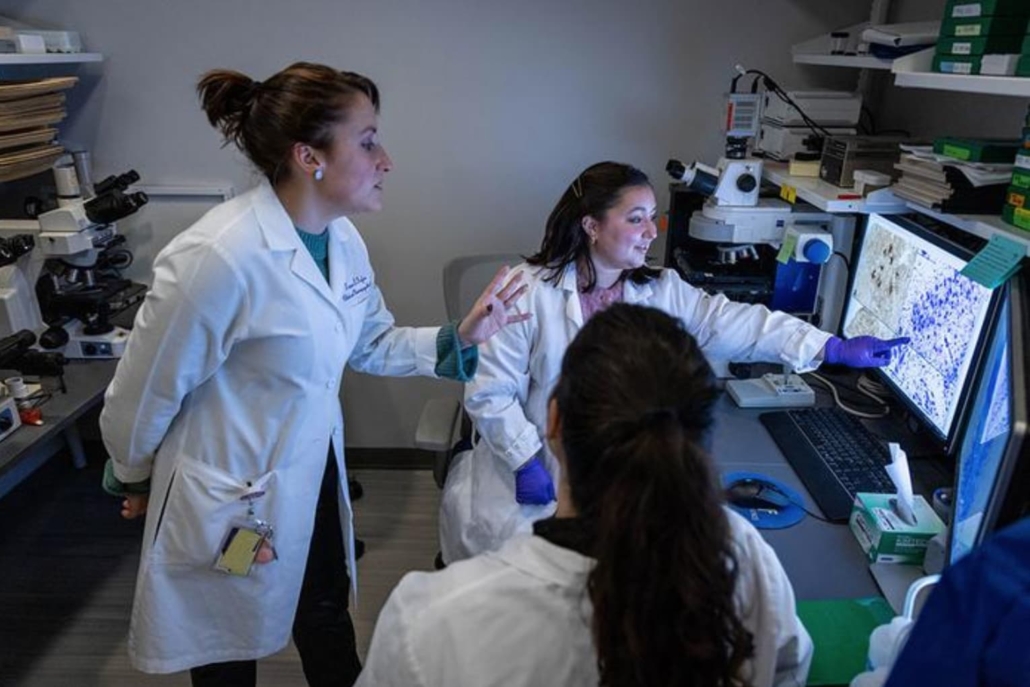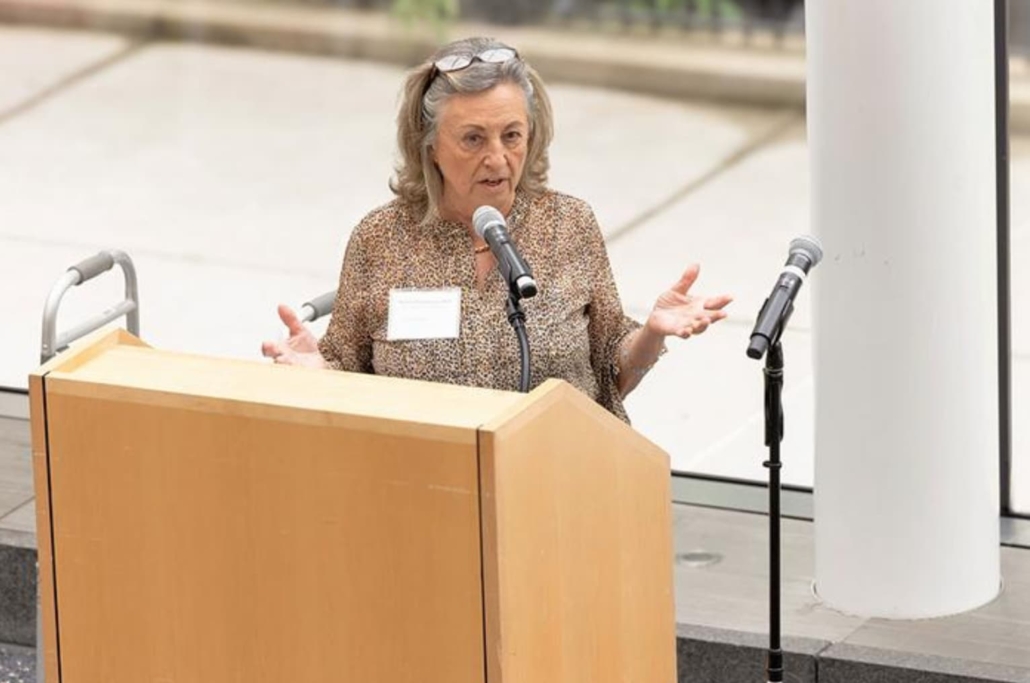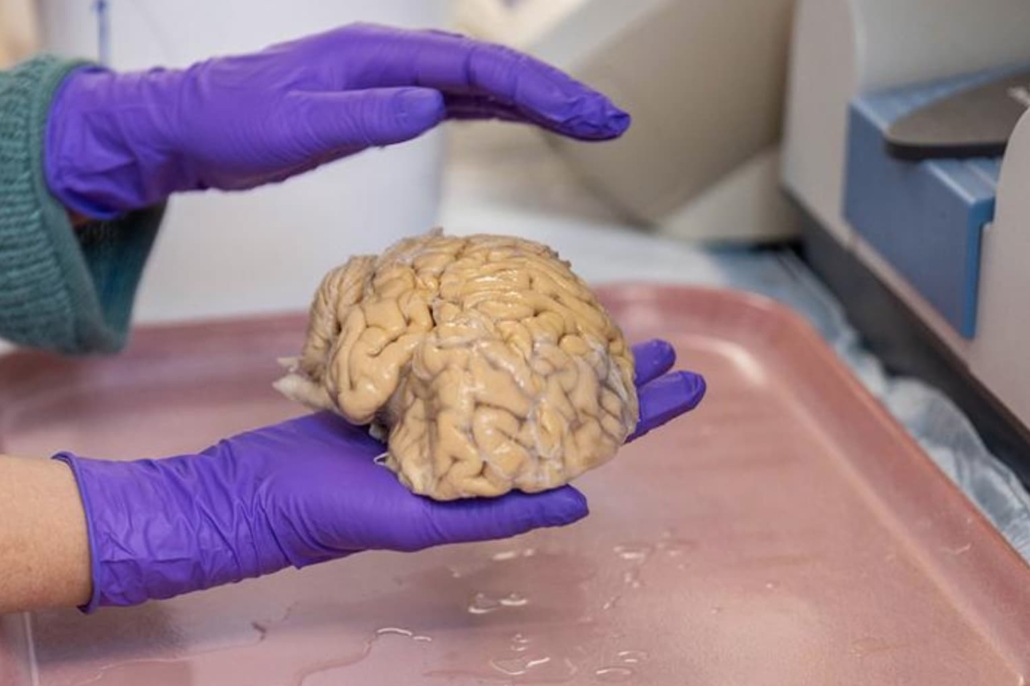25-year study reveals how SuperAgers defy cognitive decline
Twenty-five years of Northwestern University research reveals that adults over 80 with exceptional memory possess unique brain structures, greater resistance to Alzheimer’s pathology, and enhanced cellular characteristics that challenge traditional assumptions about cognitive decline during normal ageing processes in humans.

Dr. Tamar Gefen, left, observes as Allegra Kawles points to an image of neurons and neuropathology while incoming doctoral student Antonia Zouridakis looks on. In the Northwestern University lab in Chicago, IL. © Shane Collins, Northwestern
Northwestern University scientists have unveiled groundbreaking findings from a quarter-century study of “SuperAgers” – extraordinary individuals aged 80 and above whose memory performance rivals that of people three decades younger. The comprehensive research, published in Alzheimer’s & Dementia: The Journal of the Alzheimer’s Association on 7 August 2025, fundamentally challenges the long-held medical assumption that cognitive deterioration is an inevitable consequence of human ageing.
The study represents one of the most extensive investigations into exceptional cognitive ageing, tracking 290 participants and conducting detailed post-mortem analyses of 77 donated brains. The research provides compelling evidence that maintaining youthful cognitive function well into advanced age is not only possible but linked to distinct neurobiological characteristics.
Defining the super-ageing phenomenon
The Northwestern team operationally defined SuperAgers as individuals who, at age 80 or above, demonstrate delayed word recall performance on the Rey Auditory Verbal Learning Test of at least 9 out of 15 words – a score typically achieved by neurotypical adults aged 50-65. This represents a remarkably high threshold, as the average score for typical 80-year-olds is approximately 5 out of 15 words.
“Our findings show that exceptional memory in old age is not only possible but is linked to a distinct neurobiological profile. This opens the door to new interventions aimed at preserving brain health well into the later decades of life,” said Dr Sandra Weintraub, corresponding author and professor of psychiatry and behavioural sciences and neurology at Northwestern University Feinberg School of Medicine.

Corresponding study author Dr. Sandra Weintraub speaks at a SuperAger event celebrating 25 years of the program in Chicago, IL. © Teresa Crawford, Northwestern University
The research programme, initiated within the Northwestern Alzheimer’s Disease Research Centre, was sparked by a serendipitous discovery in the mid-1990s involving an 81-year-old woman whose post-mortem brain examination revealed only a single neurofibrillary tangle in the entorhinal cortex – an exceptionally rare finding for her age group.
Neurobiological signatures of exceptional ageing
The study’s most significant discoveries emerged from detailed neuroimaging and neuropathological analyses. Unlike typical ageing brains, SuperAgers demonstrated remarkable preservation of cortical thickness comparable to individuals 20-30 years younger. Longitudinal studies revealed that whilst cortical thinning remains unavoidable, it proceeds at a dramatically slower rate in SuperAgers – approximately 1.06% over 18 months compared to 2.24% in neurotypical peers.
Perhaps most surprising was the identification of a specific brain region where SuperAgers exceeded even younger adults. The anterior cingulate cortex, a crucial area involved in decision-making, emotion, and social behaviour, was significantly thicker in SuperAgers than in neurotypical participants aged 50-60. This finding has been consistently replicated across multiple independent studies.
Cellular mechanisms of cognitive resilience
The research revealed two distinct pathways to exceptional memory maintenance in advanced age: resistance and resilience. As the authors explain, “there are at least 2 pathways to the maintenance of youthful memory capacity in old brains, namely resistance to the emergence of neurofibrillary pathology and resilience to the cognitive impact of neurofibrillary pathology.”
SuperAgers demonstrated significantly fewer neurofibrillary tangles – hallmark features of Alzheimer’s disease – in critical memory regions compared to their cognitively average peers. Stereological quantitative analyses confirmed substantially reduced tau pathology in rhinal cortices, areas essential for memory processing.
“What we realized is there are two mechanisms that lead someone to become a SuperAger,” Weintraub explained. “One is resistance: they don’t make the plaques and tangles. Two is resilience: they make them, but they don’t do anything to their brains.”

A scientist at Northwestern University holds a donated SuperAger brain in Chicago, IL. © Shane Collins, Northwestern University
Unique cellular architecture
The study identified several distinctive cellular characteristics in SuperAger brains. Most notably, these individuals possessed significantly higher densities of von Economo neurons – specialised spindle-shaped cells found primarily in the anterior cingulate and frontoinsular regions. These evolutionarily advanced neurons, most prominent in humans, great apes, cetaceans, and elephants, are associated with complex social behaviours.
SuperAgers also demonstrated larger entorhinal layer 2 neurons, which provide major input to the hippocampus through the perforant pathway. This anatomical advantage may confer constitutive resistance to involutional changes or represent reactive cellular plasticity promoting resilience against pathological processes.
Enhanced cholinergic system integrity
The research revealed superior preservation of the basal forebrain cholinergic system in SuperAgers. These individuals showed significantly fewer neurofibrillary tangles in cholinergic neurons and reduced axonal abnormalities compared to neurotypical controls. Additionally, SuperAgers demonstrated lower densities of acetylcholinesterase-rich cortical neurons, potentially resulting in reduced acetylcholine degradation and enhanced neurotransmitter effectiveness.
This finding carries particular clinical significance, as cholinergic system dysfunction underlies memory impairments in both normal ageing and Alzheimer’s disease. Current Alzheimer’s treatments primarily target acetylcholinesterase inhibition to enhance cholinergic function.
Reduced neuroinflammation
Post-mortem analyses revealed significantly fewer activated microglia in SuperAger white matter compared to neurotypical brains. Activated microglia, whilst playing important roles in synaptic pruning and plasticity, can also promote harmful inflammatory processes associated with neurodegeneration. This reduced microglial activation may contribute to the preserved cognitive function observed in SuperAgers.
Social connectivity as a defining characteristic
Despite diverse lifestyle approaches, SuperAgers consistently demonstrated exceptional social engagement. The research found that whilst no particular lifestyle was universally conducive to SuperAging – with some participants following healthy regimens whilst others engaging in behaviours typically considered detrimental – all SuperAgers shared remarkable gregariousness.
“Some SuperAgers appeared to follow all conceivable recommendations for a healthy life. Others did not eat well, enjoyed smoking and drinking, shunned exercise, suffered stressful life situations, and did not sleep well,” the authors noted. However, the group was “particularly sociable and relished extracurricular activities” and “rated their relationships with others more positively” compared to cognitively average peers.
Clinical implications and future directions
The identification of the SuperAging phenotype carries profound implications for understanding cognitive ageing and developing interventions for age-related cognitive decline. The research suggests that the traditional view of inevitable cognitive deterioration with age requires substantial revision.
“Many of the findings from this paper stem from the examination of brain specimens of generous, dedicated SuperAgers who were followed for decades,” said co-author Dr Tamar Gefen, associate professor of psychiatry and behavioural sciences at Feinberg and director of the Laboratory for Translational Neuropsychology. “I am constantly amazed by how brain donation can enable discovery long after death, offering a kind of scientific immortality.”
The study’s longitudinal design provides unprecedented insights into the trajectory of exceptional cognitive ageing. One illustrative case followed a participant for 25 years, from age 67 to death at 84, demonstrating remarkable cognitive stability with delayed recall scores maintaining at 11 out of 15 words over 15 years.
Implications for therapeutic development
The comprehensive characterisation of the SuperAging phenotype may facilitate the development of targeted interventions to enhance cognitive resilience. The researchers suggest that identifying genetic factors associated with SuperAging could potentially lead to pharmaceutically modifiable protein targets promoting cognitive longevity and Alzheimer’s disease protection.
Preliminary evidence indicates that genes including KLOTHO, BDNF, ApoE, REST, and TMEM106b might influence SuperAging characteristics, though their specific relevance requires further investigation.
The Northwestern SuperAging programme continues to expand internationally, inspiring similar investigations worldwide. The research fundamentally challenges prevailing assumptions about cognitive potential in senescence and provides hope for interventions that could delay or prevent age-related cognitive decline.
As the authors conclude, “the findings so far establish the remarkable fact that remembering 9 words out of a list of 15 at age 80 serves as a marker of a distinct neurobiological signature related to brain structure and function.”
Reference
Weintraub, S., Gefen, T., Geula, C. et. al. (2025). The first 25 years of the Northwestern SuperAging program. Alzheimer’s & Dementia: The Journal of the Alzheimer’s Association, 7 August 2025.

